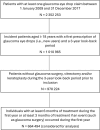Association Between Preserved Glaucoma Eye Drops Exposure and Glaucoma Surgery Occurrence: A Nationwide 10-Year Outcome Study
- PMID: 40847207
- PMCID: PMC12413382
- DOI: 10.1007/s40123-025-01203-1
Association Between Preserved Glaucoma Eye Drops Exposure and Glaucoma Surgery Occurrence: A Nationwide 10-Year Outcome Study
Abstract
Introduction: Preserved eye drops induce ocular toxicity, which may impair the management of glaucoma. This study aimed at assessing the association between the level of exposure to preserved glaucoma eye drops and the occurrence of glaucoma surgery.
Methods: This retrospective population-based cohort study included all patients ≥ 18 years old with a first glaucoma eye drops claim in the French national health insurance database between 1 January 2009 and 31 December 2017. A look-back period of 3 years before inclusion was used to select incident cases. Included patients were followed up until 31 December 2018. Patients were grouped according to the level of preservative exposure during follow-up: 0% (only preservative-free [PF] eye drops), "low-mixed" (both preserved and PF eye drops, with < 50% preserved), "high-mixed" (both preserved and PF eye drops, with ≥ 50% preserved), and 100% (preserved eye drops only) exposure. The occurrence of glaucoma surgery was analyzed for each group, and its association with preservative exposure estimated using multivariate Cox regression models, adjusted on age, sex, history of high blood pressure and cardio-neurovascular disease, glaucoma disease severity, and year of patient inclusion.
Results: We included 664,494 patients (57.0% women; median age 66.0 [interquartile range 57.0-75.0] years) with a first glaucoma eye drops claim and a median follow-up of 4.8 (2.8-7.1) years. Among them, 8,467 (1.3%) had glaucoma surgery during follow-up. The hazard ratio of glaucoma surgery increased with the level of exposure to preservatives from 2.12 (95% confidence interval 1.81-2.48) in the low-mixed group to 4.57 (3.94-5.29) in the 100% preserved group compared with the 0% preserved exposure group.
Conclusions: The risk of glaucoma surgery was associated with the level of exposure to preserved glaucoma eye drops in this nationwide cohort study. Large-scale, randomized studies would be beneficial to investigate whether PF eye drops could decrease or delay glaucoma surgery occurrence.
Keywords: Glaucoma; Glaucoma surgery; Ocular hypertension; Preservative exposure; SNDS health insurance data.
© 2025. The Author(s).
Conflict of interest statement
Declarations. Conflict of Interest: Chloé Chamard, Alain Bron, Barbara Roux, Cédric Collin, Max Villain, Eloi Debourdeau, Christophe Baudouin and Vincent Daien have no competing interests to disclose. Ethical Approval: This Study was submitted to the French Health Data Hub (HDH) in June 2019 and obtained a favorable opinion from CESREES (Ethical and Scientific Committee for Research, Studies and Evaluation in Public Health) in July 2019. The study was approved by the CNIL (French Data protection Authority) on August 2, 2019 (DR-2019-217/No 919284). Permission to access and use data from the database utilized in this study was obtained from the CNIL. As this study was a retrospective analysis of data from the SNDS, no informed consent was required.
Figures



References
-
- Gedde SJ, Vinod K, Wright MM, et al. American Academy of Ophthalmology Preferred Practice Pattern Glaucoma Panel. Primary Open-Angle Glaucoma Preferred Practice Pattern®. Ophthalmology. 2021;128:P71–150. - PubMed
-
- European Glaucoma Society (EGS). Terminology and guidelines for glaucoma. 5th ed. Savona, Italy: Dogma; 2020.
-
- Kass MA, Heuer DK, Higginbotham EJ, et al. The Ocular Hypertension Treatment Study: a randomized trial determines that topical ocular hypotensive medication delays or prevents the onset of primary open-angle glaucoma. Arch Ophthalmol. 2002;120:701–13. - PubMed
-
- Erb C, Gast U, Schremmer D. German register for glaucoma patients with dry eye. I. Basic outcome with respect to dry eye. Graefes Arch Clin Exp Ophthalmol. 2008;246:1593–601. - PubMed
-
- Baudouin C, Kolko M, Melik-Parsadaniantz S, Messmer EM. Inflammation in Glaucoma: from the back to the front of the eye, and beyond. Prog Retin Eye Res. 2021;83: 100916. - PubMed
LinkOut - more resources
Full Text Sources

